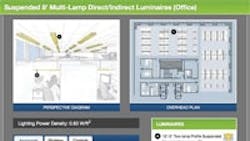DoE gives lighting designers a new software tool
The traditional way of designing energy-efficient lighting generally starts with a lamp and a ballast. But that approach comes up short in an age when the use of luminaires, vacancy sensors, demand response energy pricing, and other complications can determine what approach makes the most sense.
That's why the Dept. of Energy recently made updates to a feature on its Web site called the Commercial Lighting Solutions (CLS) online tool. The CLS gives detailed suggestions that can come in handy for cutting energy consumption for lighting needs by at least 30%.
Control strategies built into the CLS software include the use of vacancy sensors, demand response, daylight harvesting, and scene control. Expert design strategies are also part of the CLS tool and involve ballast factor tuning, fixture locations, room surface brightness, and more. Future software updates are slated to include healthcare settings as well as the ability to link directly to utilities to easily apply for rebates and other incentives.
For design engineers, the tool is useful as a benchmarking device to provide examples of best practices in lighting efficiency, from detailed specifications at the component level to expert control strategies.
“Importantly, the Web tool does not replace the design process. Rather, it provides a conceptual starting point for use by the design team. Application of the vignettes and controls templates to actual spaces will still require professional services because modeled examples will never exactly match specific projects,” explains Carol Jones, lighting program manager at DOE's Pacific Northwest National Laboratory.
Another aspect of the CLS tool is that it measures lighting efficiency in kilowatt-hours (kWh), rather than strictly comparing lighting power density (LPD), or watts used per square foot. The former is a much more accurate measure of lighting efficiency because it considers energy consumption over time, taking into account energy-saving control strategies such as dimming and using daylight when available. In contrast, the traditional LPD metric only compares the types of installed equipment and doesn't take into account how the building actually operates.
Once the lighting design team has completed the design process, the CLS tool captures more detail about the lighting project in its Energy Estimator function by allowing the user to add additional spaces and modify the fixture schedule, quantities, square footage, and use of controls per space. This additional detail allows the software to generate a much more accurate estimate of kilowatt-hour savings based on the completed design.
The latest version of CLS now includes office buildings in addition to retail settings such as grocery stores. “Lighting is really the low-hanging fruit when it comes to improving a building's energy efficiency,” says Michael Myer, a PNNL lighting researcher. “It's much easier to change a building's lighting than an HVAC system or building exterior, for example.”
“So many mandates are coming down the pike regarding energy efficiency and aggressive green initiatives, but the ‘how to’ aspect is missing. What we're doing with the online CLS software is giving people a tool that provides good ideas and a place to start with lighting — a simple way to estimate energy savings over time and show examples of best practices in typical settings,” says PNNL's Jones.
Users of the free Web-based software choose the appropriate “design vignette” based on their types of buildings; vignettes are preloaded with various lighting layouts and component specifications. Each vignette also offers several control scheme options and detailed commissioning guidance.
Several vignettes and control strategies are available to suit an individual project's specific needs, and all solutions are compared with a reference building using the “space-by-space” method allowed in ASHRAE/IESNA Standard 90.1-2004, according to DOE sources. Results calculated by the software show the projected decrease in energy usage, with most solutions saving at least 30% over the baseline design, and some solutions showing savings of greater than 50%. A progress bar that runs along the bottom of the screen estimates energy savings compared with a user-selected baseline, so users can see efficiency improvements as they adjust different variables.
The CLS program is part of the DOE's Commercial Building Energy Alliances, which are private-public forums that aim to reduce energy consumption in both new and existing buildings.
One of the first and largest users of the new CLS lighting tools is the U.S. General Services Administration (GSA). GSA has more than 300 million square feet of building space under its umbrella. With that in mind, GSA is using CLS best practices as the basis for its relighting approach to Recovery Act projects, according to DOE sources. CLS specifications made available to the GSA cover interior lighting and control systems, bi-level stairwells, LED parking lot lighting, and parking garage lighting.
Lighting links
Commercial Lighting Solutions online tool, www.lightingsolutions.energy.gov
Pacific Northwest National Laboratory, www.pnl.gov
U.S. Department of Energy www.energy.gov
